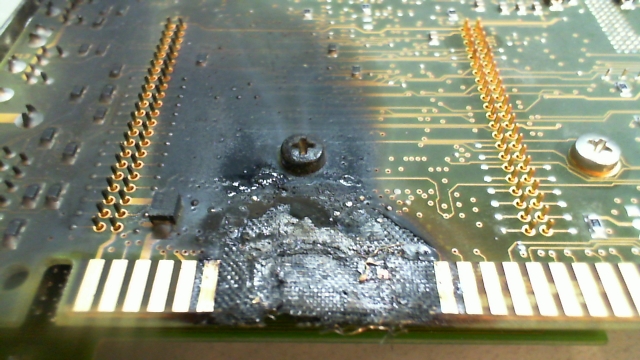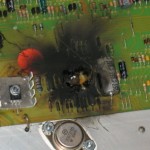Taken for granted until they fail, circuit boards are key to the operation of virtually everything these days. Many industrial printed circuit boards today are complicated, high value items that are cost effective to repair.
If your industrial electronics stop working and you are suspicious, or even absolutely certain, that your circuit board is the problem, you may need some circuit board repair, troubleshooting, or replacement advice.
Read on for a brief description of some major causes of circuit board failure and what to look for while troubleshooting.
4 Top Reasons for Circuit Board Failure and Tips to Identify the Problems & Causes:
1. Physical damage – This is plain, old physical damage such as when your NASCAR-wannabe forklift driver skewers it like a sausage on a grill. Don’t laugh…we’ve seen it happen. This kind of damage (think big holes or split in half) is sometimes repairable; often replacement is the only option if the damage is extreme.
2. Discrete Component Failure. (Includes capacitors, resistors, zener diodes, diodes, GALs, PALs, IC’s, Microprocessors, Driver Chips) Causes of failure:
- Normal component aging
- Excessive heat
- Over or under voltage surges and sags
- Rises in ESR (equivalent series resistance) values
- Corrosion and drying (esp. of electrolytic capacitors)
These problems can sometimes be visible to the naked eye such as blown/burned/melted components or obvious corrosion, but usually these items need to be checked with multimeters and/or oscilloscope.
3. Power Component Failure. (Includes transformers, transistors, IGBT modules, rectifiers). Causes of failure:
- Heat
- Over or under voltage
- Normal component aging
Some problems can be visible such as exploded components, or, more often, they could appear perfectly good on the outside but be damaged inside and require meter testing of each component. You would also likely smell a “burnt electronics” odor.
4. Trace Damage. (These are the conductive pathways, tracks or signal traces etched from copper sheets and laminated onto the non-conductive substrate) Causes of trace damage:
- Power surges
- Lightning strikes
- Use of inappropriate acid core solder causing shorts
- Contamination such as metallic dust (common in manufacturing facilities)
Trace damage is often visible to the naked eye and can usually, though not always, be repaired. Look for burn marks, solder blobs, and broken traces.
Repairing printed circuit boards can be a bit like surgery: lots of testing, probing and prepping followed by precise repair work and retesting before the patient is ready to go back to work. The good news is, your printed circuit board is most likely repairable.
Still not sure what the problem is with your circuit board? If it’s still under warranty, contact your OEM. If it is out of warranty, contact an independent industrial electronic repair center. They should offer free evaluations for your circuit board and, if needed, a free quote for repairs. They should also provide repair reports and a good warranty of a least one year that covers both parts and labor.
About the Author: ACS Industrial Services is an independent industrial electronic repair center providing repair services for printed circuit boards of all types and manufacturers, drives, servo motors, encoders, monitors and touchscreens, PLCs, test equipment, and much more. Our customer service team is available to answer your questions and help solve your industrial electronic repair concerns. You can reach them by calling 800-605-6419 or going to www.acsindustrial.com .


